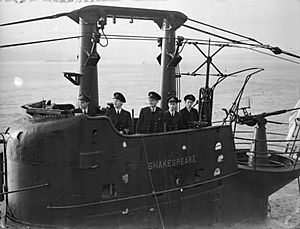Type 291 radar facts for kids

The conning tower of the submarine HMS Shakespeare showing a Type 291W radar set
|
|
| Country of origin | United Kingdom |
|---|---|
| Introduced | 1942 |
| Type | Search radar |
| Frequency | 214 MHz |
| PRF | 500 per second |
| Beamwidth | 40° |
| Pulsewidth | 1.1 μs |
| Range | 9 nmi (17 km; 10 mi) |
| Power | 100 kW |
The Type 291 radar was like a special "eye" that helped ships and submarines see things far away. It could work even in the dark or fog. This important piece of equipment was created in 1942 during World War II by the United Kingdom. It was designed to find other ships and even aircraft.
Contents
Type 291 Radar: Seeing in the Dark During World War II
The Type 291 radar was a very important tool for the Royal Navy and its allies during World War II. It helped them find enemy ships and submarines. This radar was especially useful for smaller ships like destroyers and escort ships.
How Radar Works
Radar stands for Radio Detection and Ranging. It uses radio waves to find objects. A radar sends out a radio wave, and if the wave hits something, it bounces back. The radar then "listens" for this returning echo. By measuring how long it takes for the echo to return, the radar can figure out how far away an object is. It can also tell the direction of the object.
Where the Type 291 Radar Was Used
By the end of World War II, the Type 291 radar was installed on many different types of ships. It was used on almost every British and Commonwealth destroyer. It was also found on escort ships, which protected convoys of merchant ships. Many submarines, naval trawlers, and fast motor torpedo boats also used this radar.
Some of these radar sets were even sent to the Soviet Union. This was part of a program called Lend-Lease. This program allowed the United States to provide military aid to its allies during the war.
Different Versions of the Type 291 Radar
The first version of the Type 291 radar had two separate parts. One part sent out the radio waves, and another part received the echoes. Soon after, engineers combined these two parts into a single unit. This made the radar easier to use and install.
Improving the Radar
The very first Type 291 radar had an antenna that had to be moved by hand. This meant someone had to physically turn it to look in different directions. Later versions, like the Type 291M, P, and Q, were much more advanced. They had "power training," which meant the antenna could be moved automatically by a motor.
These improved versions also included a new display called a plan position indicator. This display showed a map-like view of the area around the ship. It made it much easier for operators to see where other ships or objects were located.
Special Versions for Different Needs
Engineers also created special versions of the Type 291 radar for specific uses.
- The U variant was designed for coastal craft. These are smaller boats that operate closer to shore.
- The W variant was made for submarines. This version was built to work well in the unique conditions of a submarine. The image in the infobox shows a Type 291W radar on a submarine.
The Type 291 radar was a key piece of technology that helped the Allies win the war at sea. It allowed their ships to detect threats and navigate more safely.

